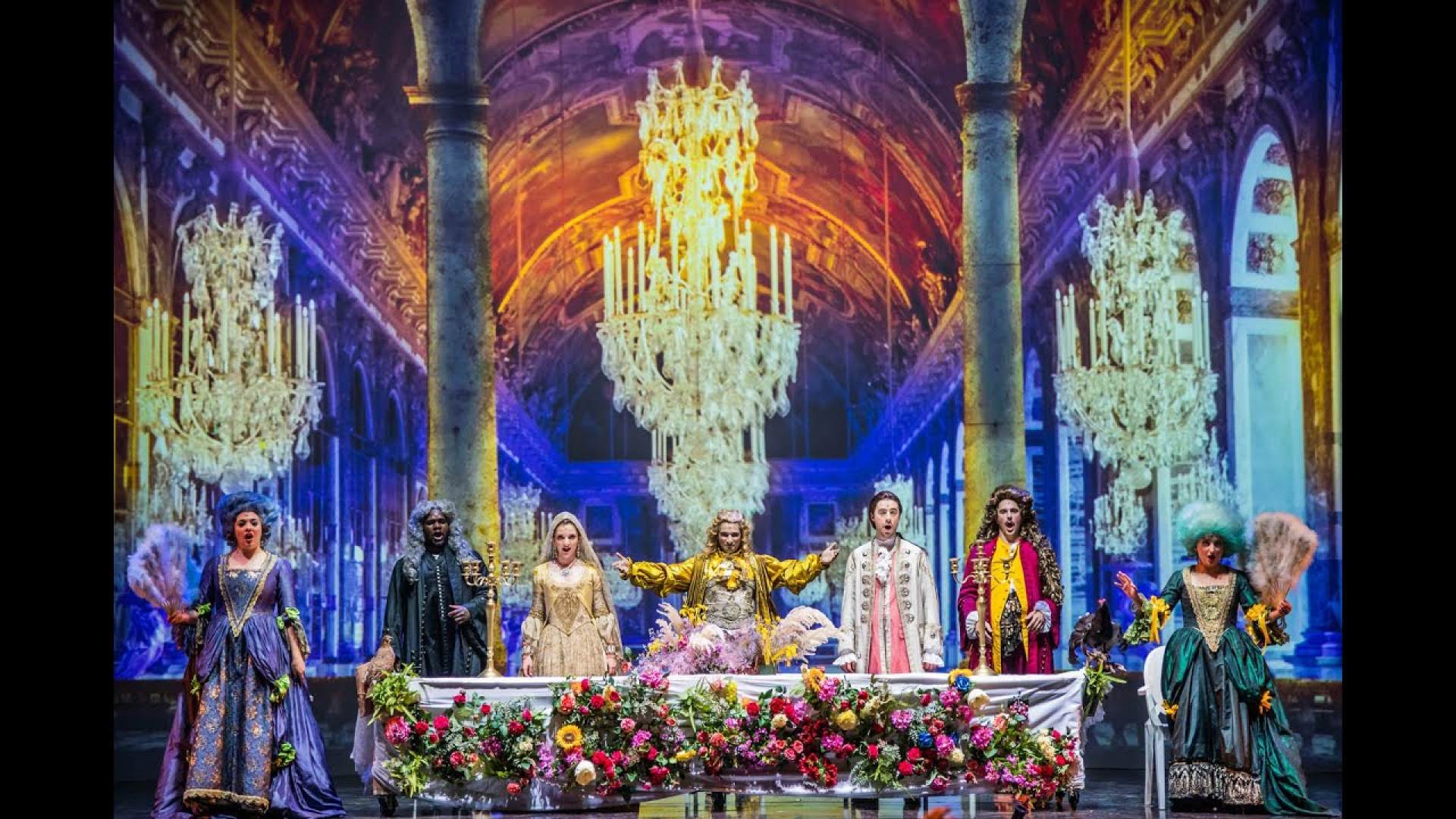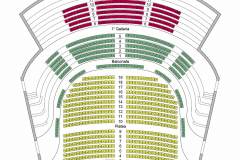La Cenerentola (Cinderella)
November 2024 | ||||||
|---|---|---|---|---|---|---|
Mo | Tu | We | Th | Fr | Sa | Su |
Act I
SCENE 1 (DON MAGNIFICO’S CASTLE)
Tisbe and Clorinda, the daughters of Don Magnifico, are adorning themselves extravagantly, and indulging in ecstasies of self-admiration. Cenerentola, their stepsister, sings resignedly to herself as she does the housework. There is a knock at the door and Alidoro appears. He is in fact a philosopher and the Prince’s tutor, but at the moment he is disguised as a beggar, the better to observe human behaviour and to ascertain if any young girl in the region is a suitable wife for the Prince. When he asks for charity, the sisters order him out, but Cenerentola secretly gives him coffee and bread. Then a member of the Prince’s retinue announces that the Prince himself will shortly arrive and invites Don Magnifico and his daughters to a ball at which he will choose his future wife. While the stepsisters order Cenerentola to make preparations, Don Magnifico enters in a dressing gown and nightcap and relates a dream he has just had of a donkey which sprouted wings and flew up to the top of a church tower. He at once interprets it: the donkey is himself, the wings are his two daughters, the church means a marriage and the flight to the top of the tower means a rise in the social scale.
Prince Ramiro appears disguised as his own valet, Dandini. He has come on Alidoro’s advice, to spy out the land. The first person he sees is Cenerentola, and their attraction to each other is instantaneous. Ramiro asks who she is, but in her agitation she can give only a confused account of herself. Cenerentola is once more called away by the stepsisters and the Baron reappears in gala clothes and is warned by the supposed valet of his master’s approach. Dandini, dressed as the Prince, now enters with the royal suite. He is received with extreme obsequiousness by Don Magnifico and his two daughters, whom he delights by his pretended attentions. He invites them to accompany him to his coach to the ball and they are on the point of starting when Cenrentola intervenes and begs to be allowed to go too. Her stepfather brutally refuses, explaining to the supposed Prince that she is a creature of the lowest birth. Just then Alidoro reappears, no longer as a beggar and declares that, according to the parish register, the Baron has three daughters. Where, he asks, is the third one? Don Magnifico, in some embarrassment, explains that she is dead and silences Cenerentola’s protests with threats. Thereupon they all go out, leaving Cenerentola by herself. But a moment later Alidoro returns and tells her that she shall go to the ball after all; he has provided a coach and the richest clothes and jewels. With the reflection that all the world’s a stage, he leads her off to the coach.
SCENE II (PRINCE RAMIRO’S PALACE)
Ramiro and Dandini enter with the Baron and his two daughters. Dandini, still in his role of prince, appoints the Baron as Royal Butler and decorates him with the chain of office.
The Baron goes off to inspect the cellars. Ramiro instructs Dandini to test the characters of the two ladies and report to him later. Dandini, left alone with them, does his best to pay equal court to each, and then, overwhelmed by their attention, makes his escape.
Don Magnifico celebrates his appointment as Royal Butler by a ritual tasting of the Prince’s wines. He dictates a proclamation to be posted all over the city, forbidding the addition of water to wine for the next 15 years, under pain of death. Overcome by the exercise of his duties, he is carried away by the attendants.
Dandini rejoins the Prince and describes the sisters’ vanity and insolence. They presently return, and Dandini, explaining that he can marry only one of them, suggests that the other shall marry his valet. They both indignantly refuse to consider such a plebeian union. Alidoro now approaches and announces the arrival of an unknown and masked lady.
The stepsisters show signs of jealousy, which increases at the entrance of the newcomer. She is last persuaded to remove her mask and everyone is amazed by her beauty. The sisters are struck by her resemblance to Cenerentola. The whole company adjourns to supper.
Act II
SCENE I (PRINCE RAMIRO’S PALACE)
Ramiro suspects that Dandini has also fallen in love with the mysterious lady and conceals himself as they approach. Dandini in fact begins to make love to her, but she rejects his advances and declares that she herself is in love with someone else — with his valet. Ramiro discloses himself, but the lady announces that before the can be betrothed Ramiro must discover who she really is. She gives him one of a pair of bracelets, tells him that she will always wear the other so that he can recognise her by it when he finds her, and departs.
Ramiro decides to end his masquerade and resume the attributes of royalty. He decides, too, to follow the unknown lady to the ends of the earth, and goes in pursuit of her. Alidoro, who has been secretly watching events, determines to arrange that the Prince’s coach shall be upset when he is in the neighbourhood of the Baron’s castle.
Dandini is now joined by the Baron and, under an oath of secrecy, admits that he is not really the Prince. The Baron’s indignation knows no bounds.
SCENE II (DON MAGNIFICO’S CASTLE)
Cenerentola is once more singing to herself by the fire. Her stepsisters back from the ball, are again struck by her resemblance to the unknown lady. The Baron is raging against the valet, when Dandini rushes in, followed quickly by Ramiro, who is now revealed to everyone as the true Prince. He recognises the bracelet on Cenerentola’s arm, and to the surprise and anger of the Baron and his daughters, pronounces her his chosen bride.
SCENE III (THE GRAND SALON IN PRINCE RAMIRO’S PALACE)
Cenerentola, now Ramiro’s bride, proclaims from the throne to the Baron and his daughters that her revenge for their cruelty is to be forgiveness.
Program and cast
DISTRIBUTION
Thomas Hengelbrock | direction
Damiano Michieletto | staging
Paul Fantin | scenography
Agostino Cavalca | suits
Alessandro Carletti | lights
Rocafilm | video
Chiara Vecchi | choreography
Marina Viotti | Angelina
Levy Sekgapane | Don Ramiro
Edward Nelson | Dandini
Peter Kalman | Don Magnifico
Alice Rossi | Clorinda
Justyna Ołów | Tisbe
Alexandros Stavrakakis | Alidoro
Balthasar Neumann Orchestra
Balthasar Neumann Choir
Teatro Filarmonico
The Teatro Filarmonico or Verona Philharmonic Theatre is the main opera theater inVerona, Italy, and is one of the leading Opera Houses in Europe. Having been built in 1716, and later rebuilt after a fire of January 21, 1749, and again after the allied bombing of February 23, 1945.
Verona needed an opera house, so it was decided in the early 18th century to build a theatre worthy and large. Work began in 1716 and lasted 13 years. Finally, inauguration was on the evening of January 6, 1732, with the pastoral drama La Fida Ninfa by Antonio Vivaldi, a libretto by Scipio Maffei. The opera season became famous, and the performances led society events. But on January 21, 1749, fire eventually spread in the theatre. Rebuilt, the theater was re-dedicated in 1754 with the opera Lucio Vero by Neapolitan composer Davide Perez. The opera had a limited success. Corsican in the 18th century, during the French invasion, a long series of celebrations were held in the theater, such as the Cantata per la Santa Alleanza ("Cantata for the Holy Alliance") of Gioachino Rossini. The theater hosted international singers, and among its repertoire appear the most famous works of Italian and foreign melodrama.
On the tragic night of February 23, 1945, the theater collapsed under the Anglo-American bombing. The Academy Philharmonic announced that it would try to rebuild the theatre exactly as it had been before. The proceedings lasted a long time: the theatre was inaugurated again in 1975, with the opera Falstaff by Antonio Salieri.
The theatre still hosts in the winter season works, ballets and concerts.

 EN
EN DE
DE IT
IT FR
FR ES
ES RU
RU JP
JP RO
RO
 Seating plan
Seating plan 